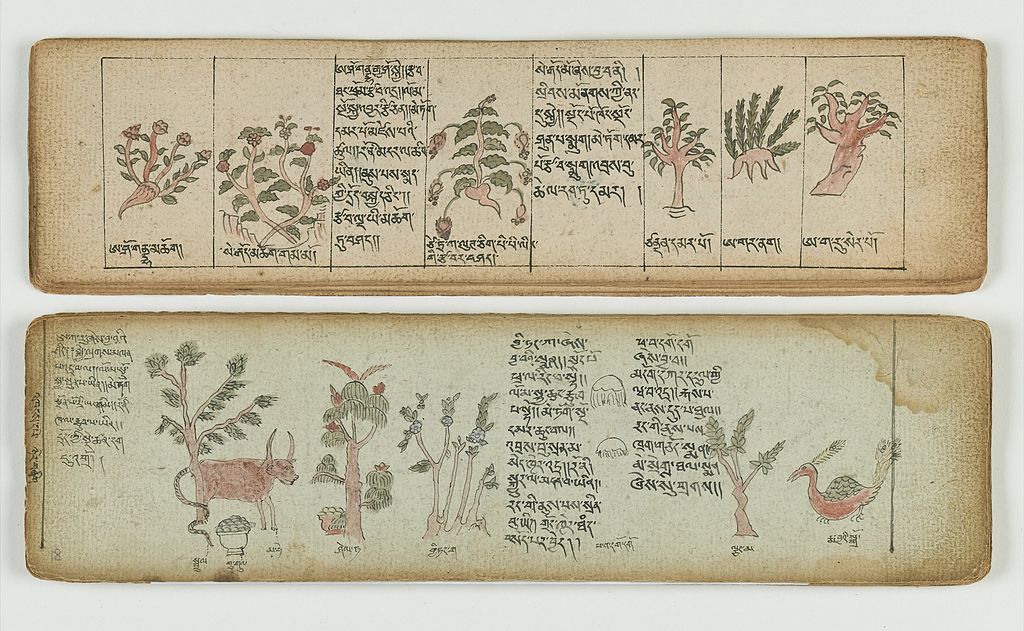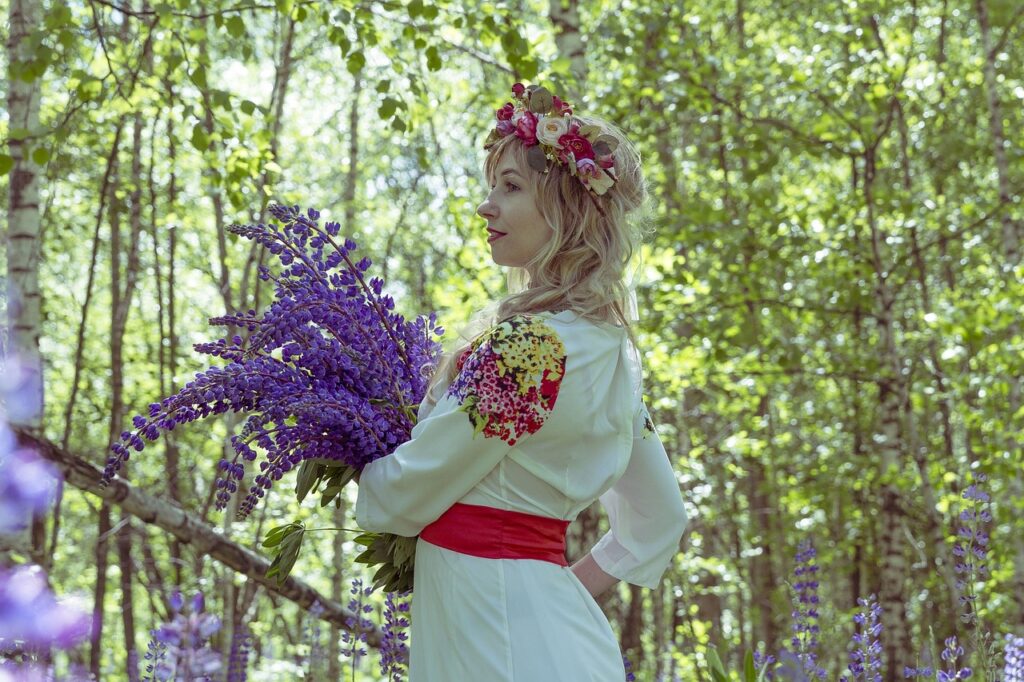Unveiling the Mystical World of Herbs
Herbs have played an integral role in human history, not only as sources of flavor, fragrance, and medicine but also as carriers of deep herb folklore and symbolism.
Throughout the ages, herbs have been infused with mystical meanings and often associated with legends, myths, and religious beliefs.

See page for author, CC BY 4.0, via Wikimedia Commons
So, let’s take a few minutes and tap into this rich tapestry and unearth some captivating stories and traditions that have surrounded these botanical wonders.
Herb Folklore and Symbolism – Beliefs, Legends and Myths
Herbs are far more than just plants; they are powerful symbols deeply woven into the fabric of human culture. For example:
- St. John’s Wort
- Bay Laurel
- Sage
- Rosemary
- Lavender
- Thyme
- Mint
1. St. John’s Wort: A Guardian Against Devils
One of the most intriguing examples of herb folklore is that of St. John’s Wort (Hypericum perforatum). For centuries, this plant was believed to possess the power to drive out evil spirits.
With the spread of Christianity, it became associated with St. John the Baptist, hence its name.
The plant was believed to bloom first on his birthday, June 24, and to bleed red oil from its leaf glands on the day in August when he was beheaded.
This association with St. John gave the herb an aura of protection. It was used to ward off malevolent forces, hung over doorways and windows, or carried as an amulet.
Furthermore, it was believed that the plant was most potent if harvested for medicinal purposes on St. John’s Day. This tradition highlights the deep connection between folklore, religion, and the practical uses of herbs in people’s lives.
2. Bay Leaves: Symbols of Peace and Victory
The bay laurel, or Laurus nobilis, has a long history of symbolism associated with peace and victory.
In ancient Rome, bay leaf wreaths were employed as a powerful emblem of success and honor.
Victorious generals and athletes were often crowned with these aromatic wreaths in grand ceremonies.
The Roman tradition of using bay leaves as a symbol of victory is evident in the term “baccalaureate,” which is derived from “bacca lauri,” meaning “laurel berry.”
This tradition carried through the centuries and is still seen today in the use of laurel wreaths as academic regalia.
In Greek mythology, the bay laurel was also sacred to Apollo, the god of prophecy and the arts. It was believed that chewing bay leaves could inspire visions and connect the chewer to the divine.
3. Sage: Cleansing and Wisdom
Sage (Salvia officinalis) is a herb steeped in folklore and symbolism, often associated with wisdom and cleansing.
Native American cultures have long used white sage, or Salvia apiana, in purification rituals. The practice of smudging, where the leaves are burned to release their aromatic smoke, is believed to clear negative energies and purify spaces.
In European folklore, sage was considered a symbol of wisdom and immortality.
Its name, Salvia, is derived from the Latin word “salvere,” which means “to be saved” or “to heal.”
This reflects the herb’s historical use as a remedy for various ailments.
It was also believed that growing sage in one’s garden would bring wisdom and prosperity to the household.
4. Rosemary: Remembrance and Love
Rosemary (Rosmarinus officinalis) is another herb deeply rooted in folklore and symbolism.
In ancient Greece, it was associated with the goddess Aphrodite (Greek goddess of love and beauty). It was often used in wedding ceremonies as a symbol of love and fidelity.
It was believed to strengthen memory, and students would wear rosemary garlands during exams to aid their recall.
During the Middle Ages, rosemary was considered a protective herb and was often placed under pillows to ward off nightmares.
Additionally, it was used in funerals as a symbol of remembrance and to ensure the deceased would not be forgotten.
In Shakespeare’s play “Hamlet,” Ophelia famously says, “There’s rosemary, that’s for remembrance.” This line encapsulates the herb’s role in preserving memories and honoring the departed.

5. Lavender: The Herb of Calm and Purity
Lavender (Lavandula) is renowned for its soothing fragrance and therapeutic properties. In folklore, it has been associated with tranquility, purity, and protection.
In ancient Egypt, it was used in the embalming process, highlighting its connection to preservation and purification.
Lavender was also believed to ward off evil spirits, making it a popular choice for sachets and wreaths. Its name is derived from the Latin word “lavare,” meaning “to wash,” reflecting its historical use in bathing rituals.
In medieval times, lavender was used to ward off the plague, and it was often planted around homes to protect against disease.
Its calming scent has made it a popular choice for sachets placed under pillows to promote restful sleep.
6. Thyme: Courage and Strength
Thyme (Thymus vulgaris) has a rich history of symbolism tied to courage, strength, and vitality.
In ancient Greece, it was associated with the concept of courage and was often used to prepare soldiers for battle.
In the Middle Ages, it was believed that thyme had the power to dispel melancholy and instill courage.
Thyme has also been connected to love and affection. In the Victorian language of flowers, it symbolized a deep affection between the giver and the recipient.
It was often given as a token of admiration and respect.
7. Mint: Vitality and Protection
Mint (Mentha) is celebrated in folklore for its refreshing aroma and its associations with vitality and protection.
It was believed to have protective qualities, often placed near entrances to homes to ward off negative influences.
In ancient Greece, mint was associated with the god Pluto, the ruler of the underworld.
It was also considered a symbol of hospitality and was commonly used to flavor food and drinks offered to guests.
Mint tea, in particular, is known for its soothing properties and is still enjoyed as a symbol of warmth and welcome in many cultures.
Herb Folklore and Symbolism
The world of herbs is not limited to their culinary or medicinal uses; it also encompasses a rich tapestry of folklore and symbolism.
Understanding the folklore and symbolism of herbs adds depth to our appreciation of these natural wonders.
It reminds us that they have served not only as sources of nourishment and healing but also as conduits for the human imagination and the expression of our most profound beliefs and emotions.
Whether we use them in our gardens, kitchens, or spiritual practices, herbs continue to enrich our lives in myriad ways, connecting us to the wisdom of the past and the possibilities of the future.
(Here is the website article that inspired me to write more about this.)
